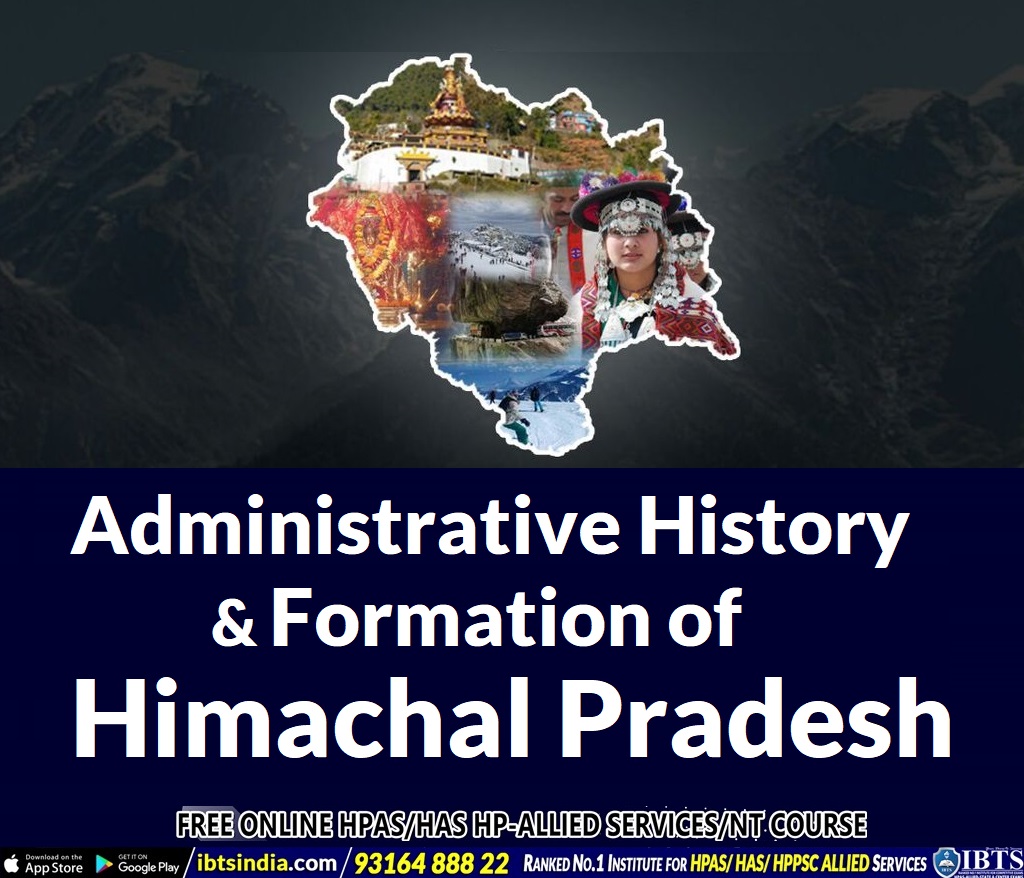Administrative History & Formation of Himachal Pradesh
Himachal Pradesh came into being as a centrally administered Chief Commissioner’s Province on April 15, 1948. It was made by integrating 26 Shimla hill States and 4 Punjab hill states (a total of 30 erstwhile Princely States) with its headquarters in the historic building of the British India Foreign Office at Shimla. At that time there were four districts viz Chamba, Mahasu, Mandi, and Sirmour, with an area of 27018 sq. km and a population was 9,35000. Sh. N.C. Mehta was appointed the first Chief Commissioner and E.P.Moon the first Vice-Chief Commissioner.
The Chief Commissioner was aided and advised in the discharge of his functions by an Advisory Council consisting of nine members, three of whom represented the erstwhile princely states and Six were public representatives.
Vide Section 3 of the Govt. of India Part ‘C’ states Act, 1951 passed in September 1951 Himachal Pradesh was designated as a Part ‘C’ state.
On March 1, 1952, Major General Himmat Singh was appointed as the first Lt. Governor of the state. The first general election to the 36 membered H.P. Legislative Assembly was held on November 1951. Congress emerged as the majority party with 24 seats. On March 24, 1952, Dr. Y.S. Parmar became the first Chief Minister of Himachal Pradesh.
On July 1, 1954 Part ‘C’ state Bilaspur was merged with Himachal Pradesh. It became the 5th district of Himachal Pradesh and the areas of the state increased to 28185 sq km. The strength of the Legislative Assembly also raised to 41.
On December 29, 1953, the States Reorganization Commission was appointed under the Chairmanship of Justice Fazil Ali, and its two members were Dr. K.M. Pannikar and H.N. Kunjru. The Commission recommended the merger of Himachal Pradesh with Punjab by a majority verdict of two against one vote. It was the Commission’s Chairman Fazil Ali, who desired H.P. to be kept separate for development purposes for some years. Finally, with the pioneering efforts of Dr. Y.S. Parmar Himachal Pradesh became the Union Territory on November 1, 1956, & was placed under an administrator designated as Lt. Governor. Sh. Bajrang Bahadur Singh was appointed as the Lt.Governor. Himachal Pradesh remained as Union Territory from November 1, 1956, to January 25, 1971.
The formation of Union Territory led to the abolition of the Legislative Assembly and under the Union Territories Act, 41 membered Territorial Council was set up in December 1956.
In May-June 1957, the Territorial Council held elections, and Congress won the majority. On August 15. 1957. Thakur Karam Singh of Mandi was elected as the Chairman of the Territorial Council.
On May 1, 1960 “Chinni” tehsil of Mahasu District named Kinnaur was carved out as the 6th district of H.P. Under the Union Territories Act, 1963, the H.P. Territorial Council was converted into the Legislative Assembly. The strength of the Assembly was fixed at 43 including 2 nominated members. This democratic set up was restored and the popular Ministry was again installed. On July 1, 1963, Dr. Y.S. Parmar became the Chief Minister of Himachal Pradesh for the second time. The Assembly held its first sitting on October 1, 1963 Continuity of the Assembly is considered this date hence its silver jubilee was celebrated in the year 1988.
With the reorganization of Punjab Hill Areas on November 1, 1966, four more districts of Kangra, Kullu, Lahaul-Spiti, Shimla along with the Nalagarh area of Ambala District and parts of Una tehsil of Hoshiarpur District and Dalhousie and Bakloh of Gurdaspur District, were integrated with Himachal Pradesh. Now the total geographical area of Himachal Pradesh increased by 96% to 55,673 sq. km and the number of districts increased from six to ten. With the merger of the new regions into Himachal Pradesh, the number of members in the Vidhan Sabha rose to 56 including 2 nominated. The strength of the house was further raised to 63 (60 elected and 3 nominated) after section 24 (3) of the Punjab Reorganization Act, 1966 came into force in 1967. In 1967 elections were held for 63 membered Legislative Assembly and Congress emerged as the leading party with 37 seats. Dr. Y.S. Parmar became the Chief Minister of H.P. for the third time.
On Jan 24, 1968, Himachal Pradesh Legislative Assembly passed a unanimous resolution demanding the status of a fully-fledged State for Himachal Pradesh.
On July 31, 1970, the bill for the grant of statehood was introduced in the Union Parliament; the Parliament of India passed the bill on December 18, 1970.
On Jan 25, 1971, the first woman Prime Minister of India Mrs. Indira Gandhi on Girja Maidan( now Known as the Ridge) in Shimla, inaugurated Himachal Pradesh as the 18th state of the union of India. Areawise became the 14th state of India Sh. S.Chakarvarti was appointed as the first Governor of Himachal Pradesh.
On September 1, 1972, Hamirpur and Una districts were carved out of the Kangra District while Shimla and Mahasu were reorganized into Shimla and Solan Districts. Now the number of districts in H.P. raised from ten to twelve viz Bilaspur, Chamba, Hamirpur, Kangra, Kinnaur, Kullu, Lahaul, Spiti, Mandi, Shimla, Sirmaur, Solan, and Una.
After delimitation of Assembly seats in the year 1971-72, the number of Members in the Assembly now stands at 68.
Thanks & Stay Connected for more important articles related to Himachal Pradesh GK Join Us on Telegram











